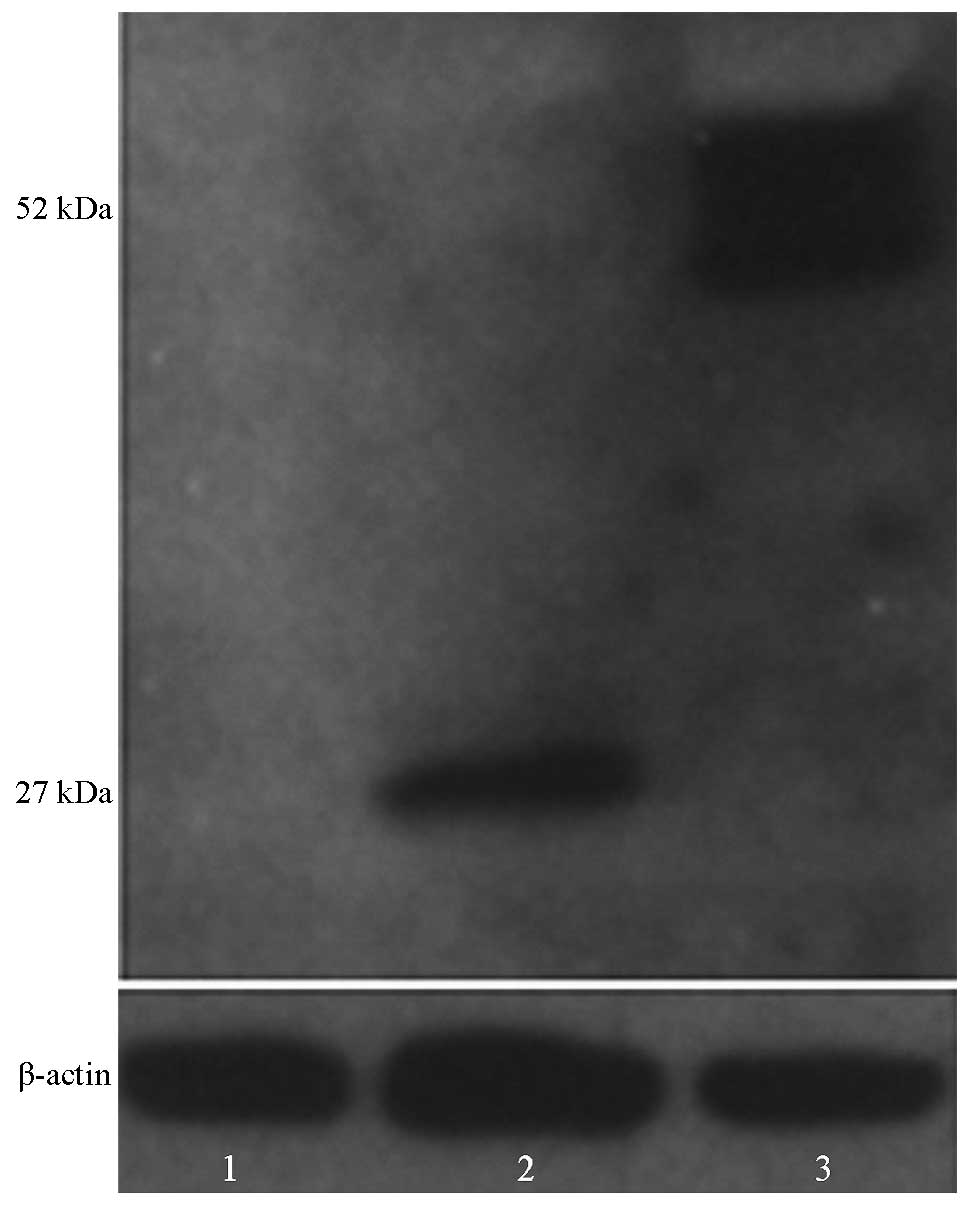|
1
|
Kovalchuk Y, Hanse E, Kafitz KW and
Konnerth A: Postsynaptic induction of BDNF-mediated long-term
potentiation. Science. 295:1729–1734. 2002. View Article : Google Scholar : PubMed/NCBI
|
|
2
|
Huang EJ and Reichardt LF: Neurotrophins:
roles in neuronal development and function. Annu Rev Neurosci.
24:677–736. 2001. View Article : Google Scholar : PubMed/NCBI
|
|
3
|
Coles LS, Diamond P, Lambrusco L, Hunter
J, Burrows J, Vadas MA and Goodall GJ: A novel mechanism of
repression of the vascular endothelial growth factor promoter, by
single strand DNA binding cold shock domain (Y-box) proteins in
normoxic fibroblasts. Nucleic Acids Res. 30:4845–4854. 2002.
View Article : Google Scholar : PubMed/NCBI
|
|
4
|
Woodbury D, Schwarz EJ, Prockop DJ and
Black IB: Adult rat and human bone marrow stromal cells
differentiate into neurons. J Neurosci Res. 61:364–370. 2000.
View Article : Google Scholar : PubMed/NCBI
|
|
5
|
Tuszynski MH, Peterson DA, Ray J, Baird A,
Nakahara Y and Gage FH: Fibroblasts genetically modified to produce
nerve growth factor induce robust neuritic ingrowth after grafting
to the spinal cord. Exp Neurol. 126:1–14. 1994. View Article : Google Scholar : PubMed/NCBI
|
|
6
|
Senut MC, Tuszynski MH, Raymon HK, et al:
Regional differences in responsiveness of adult CNS axons to grafts
of cells expressing human neurotrophin 3. Exp Neurol. 135:36–55.
1995. View Article : Google Scholar : PubMed/NCBI
|
|
7
|
Hofstetter CP, Schwarz EJ, Hess D,
Widenfalk J, El Manira A, Prockop DJ and Olson L: Marrow stromal
cells form guiding strands in the injured spinal cord and promote
recovery. Proc Natl Acad Sci USA. 99:2199–2204. 2002. View Article : Google Scholar : PubMed/NCBI
|
|
8
|
Sanchez-Ramos J, Song S, Cardozo-Pelaez F,
et al: Adult bone marrow stromal cells differentiate into neural
cells in vitro. Exp Neurol. 164:247–256. 2000. View Article : Google Scholar : PubMed/NCBI
|
|
9
|
Eriksson NP, Aldskogius H, Grant G,
Lindsay RM and Rivero-Melian C: Effects of nerve growth factor,
brain-derived neurotrophic factor and neurotrophin-3 on the laminar
distribution of transganglionically transported choleragenoid in
the spinal cord dorsal horn following transection of the sciatic
nerve in the adult rat. Neuroscience. 78:863–872. 1997. View Article : Google Scholar : PubMed/NCBI
|
|
10
|
Kesser BW and Lalwani AK: Genetherapy and
stem cell transplantation: strategies for hearing restoration. Adv
Otorhinolaryngol. 66:64–86. 2009.
|
|
11
|
Jouhilahti EM, Peltonen S and Peltonen J:
Class III beta-tubulin is a component of the mitotic spindle in
multiple cell types. J Histochem Cytochem. 56:1113–1119. 2008.
View Article : Google Scholar : PubMed/NCBI
|
|
12
|
Siminiak T and Kurpisz M: Myocardial
replacement therapy. Circulation. 108:1167–1171. 2003. View Article : Google Scholar : PubMed/NCBI
|
|
13
|
Pisati F, Bossolasco P, Meregalli M, et
al: Induction of neurotrophin expression via human adult
mesenchymal stem cells: implication for cell therapy in
neurodegenerative diseases. Cell Transplant. 16:41–55. 2007.
View Article : Google Scholar : PubMed/NCBI
|
|
14
|
Kang SK, Jun ES, Bae YC and Jung JS:
Interactions between human adipose stromal cells and mouse neural
stem cells in vitro. Brain Res Dev Brain Res. 145:141–149. 2003.
View Article : Google Scholar : PubMed/NCBI
|
|
15
|
Satomura K, Derubeis AR, Fedarko NS, et
al: Receptor tyrosine kinase expression in human bone marrow
stromal cells. J Cell Physiol. 177:426–438. 1998. View Article : Google Scholar : PubMed/NCBI
|
|
16
|
Murer MG, Yan Q and Raisman-Vozari R:
Brain-derived neurotrophic factor in the control human brain, and
in Alzheimer’s disease and Parkinson’s disease. Prog Neurobiol.
63:71–124. 2001. View Article : Google Scholar
|
|
17
|
Mason MR, Tannemaat MR, Malessy MJ and
Verhaagen J: Gene therapy for the peripheral nervous system: a
strategy to repair the injured nerve? Curr Gene Ther. 11:75–89.
2011. View Article : Google Scholar : PubMed/NCBI
|
|
18
|
Zheng N, Yin L, Song Z, et al: Maximizing
gene delivery efficiencies of cationic helical polypeptides via
balanced membrane penetration and cellular targeting. Biomaterials.
35:1302–1314. 2014. View Article : Google Scholar
|















